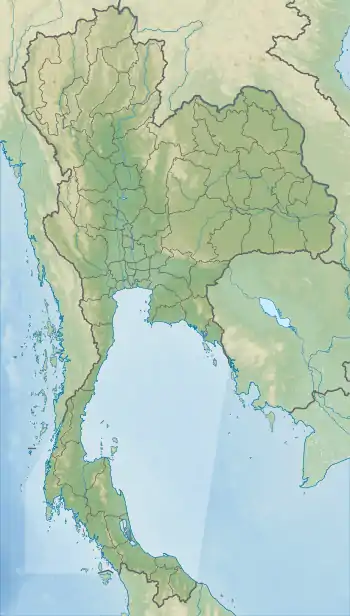Budo–Su-ngai Padi National Park
Budo–Su-ngai Padi National Park (Thai: อุทยานแห่งชาติบูโด-สุไหงปาดี) is a national park in Narathiwat Province, Thailand. It is part of Sankala Khiri mountain range, the southernmost subrange of the Tenasserim Hills that stretches from the Kra Isthmus into Malaysia.[3]
| Budo–Su-ngai Padi National Park | |
|---|---|
| อุทยานแห่งชาติบูโด-สุไหงปาดี | |
IUCN category II (national park) | |
 Map of Thailand | |
| Location | Southern Thailand |
| Coordinates | 6.467°N 101.630°E[1] |
| Area | 294 km2 (114 sq mi) |
| Established | 1999 |
| http://web3.dnp.go.th/parkreserve/asp/style1/default.asp?npid=119&lg=2 | |
History
The area was a haven for guerrillas and few people ventured in to see the natural jungle environment here. However, when the situation improved in 1974, the Royal Forest Department established Pacho Waterfall Park that became Budo–Su-ngai Padi National Park.
Geography and climate
The park has an area of 294 square kilometres (114 sq mi) and covers parts of Narathiwat, Yala and Pattani Provinces. The Budo mountain range is part of the Indo-Malayan equatorial tropical rainforest that has high humidity because of the year-round rainfall that it gets.
The park has several waterfalls, such as Phu Wae, Pacho and Pako. The best known and accessible is "Pacho", on a high cliff. The word "pacho" is a Thai corruption of the Malay word pancur meaning "waterfall".
Flora and fauna
The most distinctive plant is the "golden leaves" or "yandao". This plant was first discovered in 1988 here. The vine leaves are gold in colour, similar to a hardwood tree of the genus Bauhinia, but considerably larger. Some leaves are even larger than the palm of a hand. The edges of the leaves are curved throughout, like two connected ovals. The leaves have a soft velvet-like texture. Rare animals in the area are rhinoceros, agile gibbons, tapirs, and Sumatran serows. The most important animal is the spectacled langur that inhabits Southeast Asia in the south of Myanmar and Thailand all the way to Malaysia and some islands. It lives on high mountains and in deep jungles in groups of around 30-40. The strongest male is the leader. The langur is usually shy, afraid of humans and not aggressive like monkeys. Apart from the spectacled langur, there are three other types in Thailand; banded langurs, gray langurs, and northern spectacled langurs. All four species of langurs are endangered mammals.
References
- "Budo-Sungai Padi National Park". protectedplanet.net.
- "Budo-Sungai Padi National Park". protectedplanet.net.
- "Budo - Su-ngai Padi National Park". Department of National Parks (DNP) Thailand. Archived from the original on 10 July 2015. Retrieved 9 July 2015.